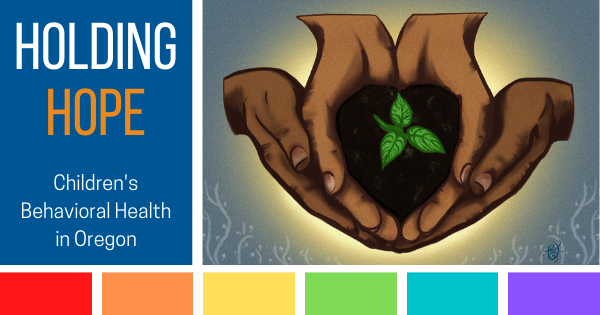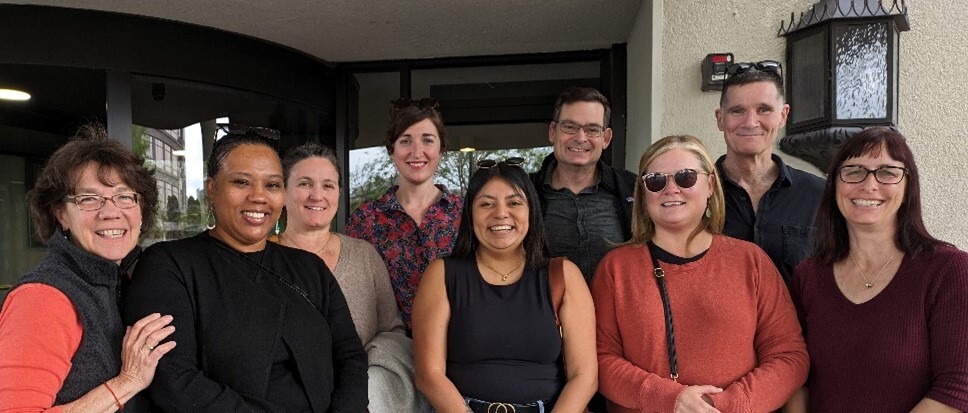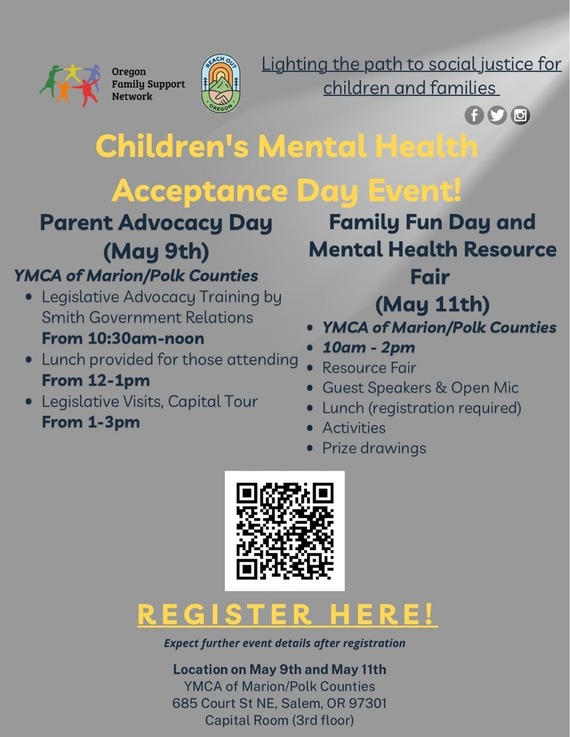|
Having trouble viewing this email? View it as a Web page.
Lea en español
 May 1, 2024
In this issue...
Reflections from Oregon Health Authority's (OHA) Child and Family Behavioral Health (CFBH) Director, Chelsea Holcomb

May is a time of new beginnings, refreshed energy and beauty in the Pacific Northwest. Flowers are blooming, warmer days are teasing us for summer and the fresh sweet air feels nourishing. I am grateful to live in such a beautiful part of the country. As we celebrate Mental Health Awareness Month, I am reminded of how we need ongoing energy to stay focused and how mental health and wellness is so much about community and connection. We need each other and those around us to support us and our mental health.
May is also filled with opportunities for connection and growth as we come outside more and spend more time in our communities in parks, famers markets and activities around our schools. I am looking forward to upcoming events that include cross-system and community connection beginning with the Oregon Alliance Annual Summit next week in Redmond, an upcoming System of Care Strategy Meeting, and an OHA-wide children’s behavioral health system conversation we are convening later in the month. We can’t do this work alone. Coming together in community and connection allows us to learn from each other, elevate and amplify the voice of youth and families, challenge ourselves to problem solve in new ways and develop trust in relationship. I look forward to telling you all more about these events in June.
Together we plant seeds, water them and watch them grow. Together we connect, support and nurture each other and our communities. I hope you can take some time this month to attend some of the celebrations and activities in your community that promote mental health awareness, education and connection.
BUILD Partner State Meeting: Oregon’s Team
In the spirit of connection and collaboration I recently had the opportunity to travel to Albuquerque, New Mexico with the Oregon team that supports early childhood work. This state meeting event was hosted by the BUILD Initiative who envision a time when all children thrive and when race, place, and income are no longer predictors of early childhood outcomes. The Oregon team is a cross-system group focused on the policies, programs and opportunities for young children, prenatal to age five. This group supports the amazing work of the Early Learning Council currently led by Sue Miller and includes child-serving state agency leaders, including OHA.
The Council has recently published Oregon’s Raise Up Oregon 2.0, a comprehensive state system plan for early childhood, prenatal to age five. The plan brings together leaders and efforts from early care and education, public education, health, housing and human services. Our team spent two full days deepening our connection and work through dedicated state team time coupled with technical assistance from BUILD. We learned from other state teams about their efforts, challenges and successes. This was used to amplify and prioritize the objectives and strategies in the Raise Up Oregon plan. This beautiful System of Care partnership deepens my hope and commitment in all areas of our continuum to work with community and cross-system partners to align priorities, efforts and problem solving. I am deeply grateful to the team below for their passion, dedication and wisdom. I am inspired!
|
 Cate Wilcox, (OHA Public Health Division; ), Chelsea Bunch, (Oregon Housing & Community Services; ), Gwyn Bachtle, (Department of Early Learning and Care (DELC); ), Lizzie Fussell, (OHA Health Policy and Analytics; ), Gabriela Hernandez, (DELC); , David Mandell, (DELC); , Kara Williams, (Oregon Department of Education; ), Bill Baney, (Oregon Department of Human Services – Self-Sufficiency; ) and Chelsea Holcomb (OHA CFBH)
One unique aspect of the BUILD meetings is the intentional effort to explore the area where they hold the meetings. This promotes education and exploration, but also inspires us to explore our own states with the same curiosity and intentionality. In New Mexico there are 23 Indian Tribes including 19 Pueblo Tribes, three Apache tribes and the Navajo Nation.
As part of this event, we visited the Indian Pueblo Cultural Center and the Sky City Cultural Center & HAAK’U Museum. We toured the Acoma Pueblo which is built atop a sheer-walled, 367-foot sandstone bluff in the desert valley. Our guide “Turtle” shared the history, customary traditions and current celebrations within his community. A quick article and a couple pictures do not do justice to this place, the people and the experience. I encourage you to visit their website. When in the area please make time to visit the Acoma Pueblo to learn their history, traditions and current art, rich culture and celebrations. And look for Turtle, who runs the café and welcomes you with an open heart.
Maureen Chavez, the Director of the Sky City Cultural Center during our tour of the Acoma Pueblo.

Turtle greets visitors at the Sky City Cultural Center
 
On Thursday, May 9, Oregon Family Support Network will host Parent Advocacy Day at the Family YMCA of Marion and Polk Counties, in the Capitol Room. Join them from 10:30 a.m. to 3 p.m. The location is 635 Court St. NE, third floor.
On Saturday, May 11, Oregon Family Support Network will host Family Fun Day and a Mental Health Resource Fair. This event will also be held in the Capitol Room of the Family YMCA of Marion and Polk Counties. Join them from 10 a.m. to 2 p.m. for this event.
Lunches will be provided both days. Please register for the day(s) you want to attend and indicate how many people you will bring, so they can plan a lunch for everybody!
Register by scanning the QR code from the flyer, or click here for English and here for Spanish.
 
Join us on May 1 to explore the results of our recent youth engagement work for the new Child and Family Behavioral Health Roadmap.
This work included classroom settings, substance use disorder outpatient groups, and shelters; geographically it spanned from the coast to Eastern Oregon and metro areas. Young people offered candid views on their priorities for behavioral health. In person we reached over 180 young people over four months and discussed the following three questions:
When you think about children and young adult mental health or substance use treatment and supports:
- What is going well?
- What could be going better?
- If you were running the system what would your top two priorities be?
Date: May 1 from 2 to 3:30 p.m.
Join ZoomGov Meeting
Join by phone: 669 254 5252: Meeting ID: 160 752 6471: Passcode: 105841
The System of Care Advisory Council (SOCAC) has spent the last eight months examining respite for youth and families and the lack of access to this service in Oregon. Their report uses a working definition of respite as:
Respite services provide a break for primary caregivers of children and youth with complex needs, as well as a break for youth themselves. Effective respite services are culturally and linguistically responsive, developmentally appropriate, flexible, and provide a range of options, from drop‐in childcare to preplanned or overnight crisis services.
SOCAC has identified two categories of respite, formal and informal respite.
- Formal respite is generally defined as services based on specific program eligibility (such as I/DD or child welfare system involvement) or a diagnosis (e.g., behavioral health condition). Formal respite is often funded, in part, by Medicaid dollars, and therefore must follow more rigid regulations and laws.
- Informal respite is more universally offered and offers more flexibility in terms of providers and settings. Informal respite isn’t linked with insurance payments and is often funded through community organizations, schools, state agency funds, and grants.
Respite is foundational to a comprehensive service delivery model for youth with behavioral health needs and related conditions. It is one of several services within a functional system of care. Aside from benefits to families and youth, respite also saves costs by preventing the need for more expensive, out of home services like residential treatment or hospitalization. Providing respite to youth and their families builds family cohesion, reduces stress for youth and caregivers, lowers economic burdens for families and the system and contributes to overall healthier communities. In spite of its importance, respite is difficult to find and access. Some of the reasons for this include lack of funding, workforce, youth‐initiated options, information about available respite, and stigma.
Tammi Paul, Oregon Family Support Network Executive Director.
Oregon Family Support Network (OFSN) is the largest family peer organization in Oregon. It provides vital service and supports to families across the state, including the Reach Out Oregon Warmline, trainings and peer supports. Tammi Paul has recently stepped into the Executive Director role. She writes, “I am honored, excited and grateful to step into the Executive Director role with Oregon Family Support Network. It is a time in which there is so much opportunity for the organization and for the families that we serve. I see the work of our Family Support Specialists each day and I am humbled by the lives that they save and the ripple effects that they have with families. It is inspiring, regenerative and not just hard work but 'heart' work!”
Her vision for OFSN is to be an organization of healing, both internally and externally. “I want OFSN to be a place in which people come, not just because they want to help others, but because they will be in an environment that supports trauma-healing, healthy relationships, kindness and the ability to flourish. My intention is to model compassionate leadership in everything that we do and to invite others to join a way of being together that resists polarization of relationships. It is my intention to lead in a way that prizes our ability to be with difference, to reach for those that may have different experiences, to seek to understand, to resist practices developed to serve only a white supremacist construct, and to slow our bodies and minds to develop meaningful relationships with system partners, families, communities and colleagues.”
Tammi has been with OFSN for 12 years. She joined in 2012 as a regional manager and is credited with developing the organization's robust training program. Most recently she has served as the Deputy Director for the past six years. Tammi’s background is in higher education administration and special education law. Her heart for the work of OFSN comes from her lived experience as a parent to a child (now young adult) who experiences ADHD and anxiety, and another child (now young adult) who experiences the autism spectrum. It is her personal goal to reduce the alienation and stigma that children with behavioral challenges face in the many aspects of their lives. Tammi and her husband own a farm north of Eugene and she loves to make goat cheese and designer soap. A weaver and fiber artist, Tammi enjoys spending time learning new ways to embrace nature and invite joy into her life.
Early and Periodic Screening, Diagnostic and Treatment (EPSDT)
Beginning Jan. 1, 2023, Oregon expanded Oregon Health Plan (OHP) benefits for youth from birth through age 21. EPSDT benefits include all medically necessary and appropriate comprehensive preventive health care services, such as:
- Age-appropriate medical exams, screening, and diagnostic services and
- Medically necessary Medicaid-covered services to treat any physical, dental, developmental, and mental health conditions discovered.
Coordinated care organizations (CCOs) cover these benefits for CCO members. OHA covers EPSDT benefits for members not enrolled in a CCO (these members have fee-for-service OHP, also known as open card coverage).
Most EPSDT services have been provided in Oregon for many years. This includes adolescent and well child visits and other routine medical, dental, and behavioral health care. For more information, visit OHA's EPSDT page.
What does this mean for behavioral health services?
Some behavioral health screenings, treatments, and services that previously were not covered due to restrictions related to the Prioritized List are now covered when medically necessary and appropriate for youth under age 21. Decisions about medical necessity and appropriateness must be made on an individual basis, not on age or diagnosis.
This can include mental health and substance use treatment, case management, personal care services, rehabilitation services, nutritional supplements/medical foods, and other appropriate supports.
What can you do to access these services?
EPSDT is part of Oregon’s Medicaid coverage, so these services are already available to all youth and young adults under age 21 who have OHP coverage through a CCO or open card.
There is a fact sheet for families and youth here.
If you feel that you have been denied services that should have been covered, you can email EPSDT.Info@odhsoha.oregon.gov for additional information.
Young adults with special health care needs (YSHCN)
In Oregon, one in five children under age 18 has a special health care need.[ More than 80 percent of YSHCN in the state don’t receive the proper tools to adequately care for their health and social needs. People identified as YSHCN frequently need more health and health-related social services than others of the same age. Providing no-cost health insurance helps these young adults to access their regular care during an important time of transition to adulthood.
Examples of special health care needs:
- Physical, intellectual, and developmental disabilities
- Long-standing medical conditions like asthma, diabetes, or spina bifida
- Behavioral health concerns like depression or substance use disorders
Who qualifies as YSHCN?
To qualify as YSHCN, a person must:
- Be 19 or 20 years old in 2025
- Have at least one qualifying health care need that began before age 19
- Have an individual or family income up to 305 percent of the federal poverty level
Current OHP members who qualify for YSHCN will automatically receive YSHCN benefits. Individuals can also complete a short set of questions in the OHP application to qualify for YSHCN.
About YSHCN benefits
Starting Jan. 1, 2025, young adults with special health care needs will:
- Qualify for enhanced vision and dental benefits and EPSDT up to their 26th birthday
- Have access to Health-Related Social Needs (HRSN) benefits
- Receive OHP coverage if they have an individual or family income up to 305% of the Federal Poverty Level
What this means for YSHCN members
Oregon is working with the Centers for Medicare & Medicaid Services on how to implement this expansion of benefits. Currently, it’s important to know that:
- In 2025, the YSHCN benefit will cover approximately 6,000 additional young adults who currently don’t qualify for OHP. In addition, approximately 16,000 current OHP members will receive enhanced benefits through YSHCN.
- Some youth will turn 21 during 2025. CCOs and OHA will need to adjust their systems to ensure that youth maintain their EPSDT and enhanced vision and dental coverage after their 21st birthday.
- CCOs and OHA will screen youth who qualify for this benefit annually to determine their need for HRSN benefits.
- YSHCN will remain enrolled in OHP for 24 months before redetermination.
- Oregon plans to expand the YSHCN category to cover people up through age 25 by 2030. YSHCN coverage in future years is subject to funding availability, but Oregon is committed to ensuring availability of YSHCN benefits as planned.
For any questions or additional information, email 1115waiver.renewal@odhsoha.oregon.gov.
Over the past several months we've shared about our new data collection tool, called Referral and Capacity Management (RCM). This section of the newsletter will display data from RCM in the next couple of months. These data will replace the previous ITS capacity graphs.
RCM is a secure web-based platform and a tool for providers to manage referrals and waitlists to their programs. RCM will give the participating providers and the CFBH team daily updates on Psychiatric Residential Treatment Facility (PRTF) referrals and PRTF bed capacity. Our previous data collection tool only recorded data on a weekly basis. At this stage substance use treatment facilities have not been added to RCM but will be added at a later date. For providers not using RCM the old system will continue to collect and report information.
With access to daily census counts (total youth in programs), as well as daily referral counts (number of referrals received), we will have a better view of the current system's PRTF bed capacity and the demand for these services. In the future these two metrics will allow us to calculate an updated system-wide PRTF bed capacity goal. Our aim is to provide a first look into the data RCM is collecting in the June or July newsletter.
Conventional wisdom says it takes about three weeks to form a new habit, so Dr. Eddie Moore, Dr. Marguerite Penick-Parks and Debby Irving developed the 21-Day Racial Equity Challenge to help all of us cultivate self-awareness and intentionality to effect social change: creating more inclusive environments, being better advocates, and using an equity lens to create a more just society.
Many of the CFBH team members have been participating in group discussions around the Michigan League for Public Policy 21 day racial equity challenge and finding it one small step in building our individual and collective awareness to create a better future for all people.
Find events, opportunities, trainings and resources in last month's posting on our newsletter page. Many of these trainings are also on our training opportunities page. We will send updates mid-month — Look for the next one in your inbox on May 15.
For feedback and suggestions for our newsletter and information: kids.team@oha.oregon.gov.
Subscribe to OHA Behavioral Health Updates
Did someone forward or share this with you? You can subscribe here to get future issues of Holding Hope and other updates for Oregon behavioral health providers and partners.
|